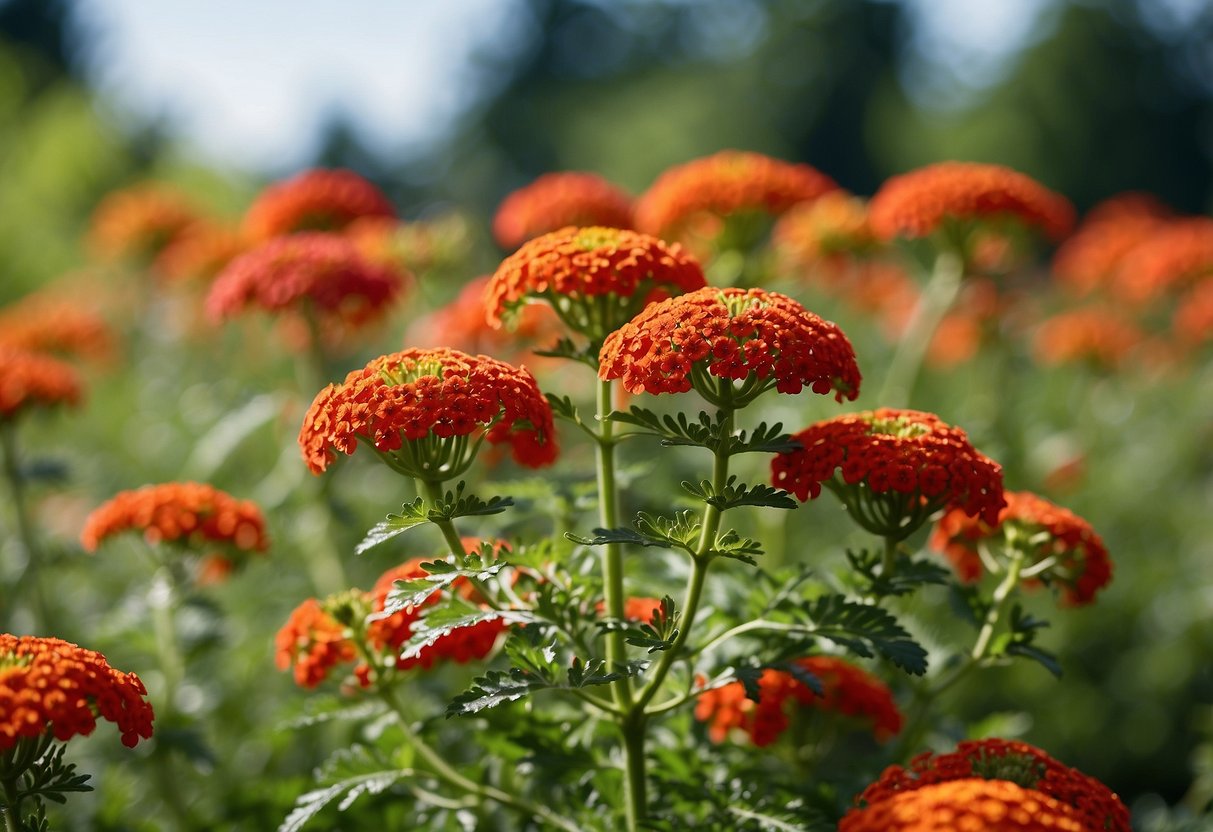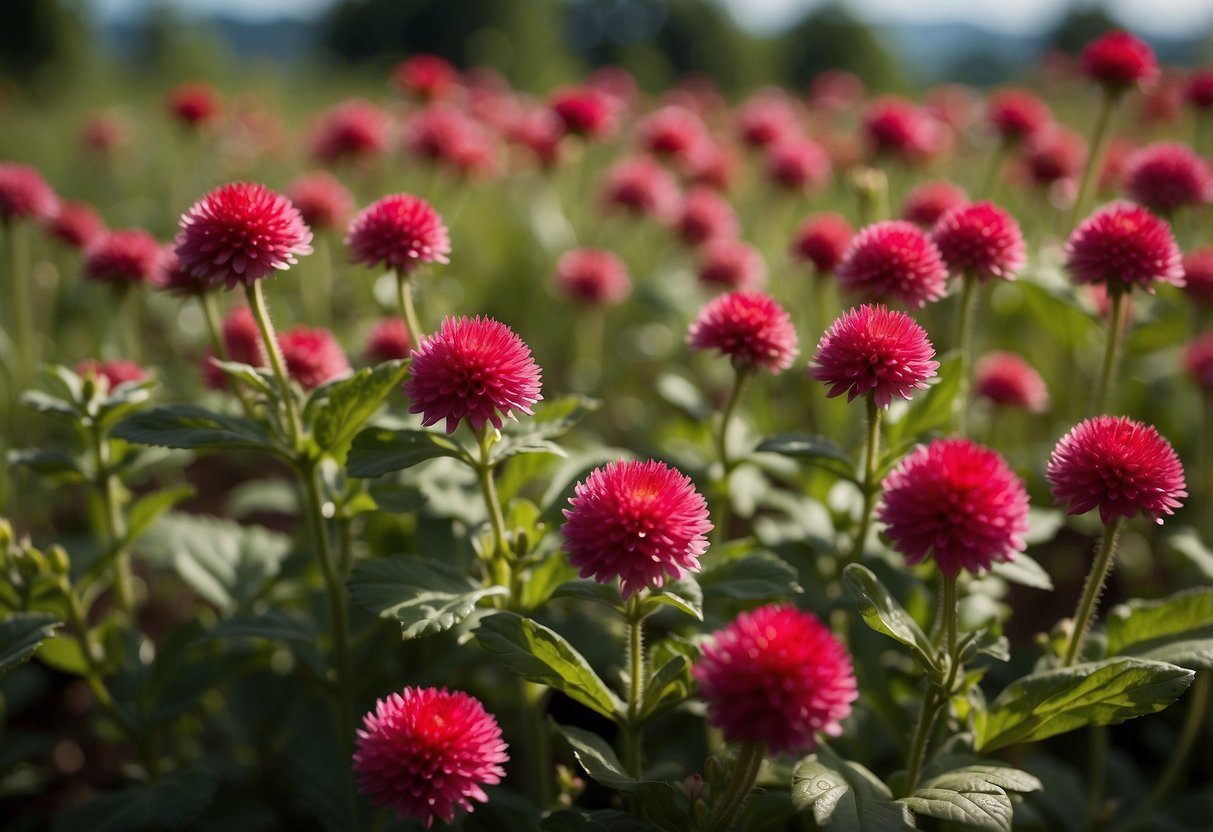Red Garden Ideas: Vibrant Inspirations for Your Backyard
Looking to add some excitement to your garden? Red flowers might be just what you need. They bring a vibrant pop of color that can make your outdoor space truly stand out.

Red flowers offer beauty and attract pollinators like hummingbirds and butterflies. Whether you prefer perennials or annuals, there are plenty of options that can thrive in various conditions. Let’s explore some ideas to help you create a stunning red garden.
1) Crimson Pygmy Barberry

Crimson Pygmy Barberry is a compact and colorful shrub perfect for red garden ideas. It grows about 18-24 inches tall and 30-36 inches wide. This plant is hardy and requires little care, making it a great choice for beginners.
The rich red-purple foliage shines best in full sun. It also produces small yellow flowers in spring, followed by red fruits enjoyed by birds. It thrives in zones 4 to 8, handling both warm and cold climates well.
For detailed planting instructions, check out the guide on How to Grow Crimson Pygmy Barberry.
2) Red Hot Poker Plants

Red Hot Poker plants are perfect for adding vibrant color to your garden. Their tall, dramatic flower spikes are sure to grab attention.
These plants thrive in zones 5-9 and are popular for their striking red and yellow blooms. They can grow up to 3-4 feet tall.
To care for them, plant in well-drained soil and full sun. Keep the soil moist but not waterlogged. They will reward you with stunning flowers from spring to fall. For more details, visit Epic Gardening.
3) Bishop of Llandaff Dahlia

The Bishop of Llandaff Dahlia boasts vibrant, fiery red blooms and dark, striking foliage. This plant can really make your garden pop with color.
To grow it, plant the tuber about 6-8 inches deep in well-drained soil. Make sure it gets plenty of sunlight.
With proper care, your Bishop of Llandaff Dahlia will become a standout feature in your garden. For more detailed growth instructions, check out this guide on how to grow Bishop Of Llandaff Dahlias.
4) Cherry Blossom Trees

Cherry blossom trees can add a touch of elegance to your garden with their beautiful blooms. They belong to the genus Prunus, which includes not just cherries but also plums and apricots.
There are many species of cherry blossom trees. For example, the Japanese Cherry, or Prunus serrulata, is known for its stunning blossoms.
If you prefer a smaller tree, consider a dwarf weeping cherry tree. They grow up to 8 – 10 feet tall and are perfect for cozy spaces.
5) Red Knock Out Roses

Red Knock Out Roses can add a bright and bold touch to your garden. These roses are easy to care for and can bloom from spring through fall.
Mix them with other plants like boxwoods for a formal look. For a more playful touch, try pairing them with dianthus or Shasta daisies.
Consider using Red Knock Out Roses to create a focal point in your garden. Place them in a central spot surrounded by low-growing foliage to make them stand out.
6) Paprika Yarrow

Paprika Yarrow is a vibrant plant that adds a splash of red to your garden. Its bright red flowers gradually change to light pink and creamy yellow as they age. This color transformation creates a beautiful display throughout the summer.
The foliage of Paprika Yarrow is green and fern-like, giving it a pleasant aroma. This plant thrives in full sunlight and well-draining soil. For more details, visit Gardenia.net.
7) Fireworks Red Fountain Grass

Fireworks red fountain grass is a stunning addition to any garden. This variety has colorful, variegated leaves with shades of burgundy-red, hot-pink, and green.
With an upright and arching growth habit, it can add height and visual interest. It typically reaches 24-36 inches tall and thrives in full sun.
In mid to late summer, you’ll enjoy long crimson plumes on arching stems. This unique grass is non-invasive, making it easier to manage in your garden. Consider planting it as a focal point or alongside other vibrant plants. For more landscaping ideas, visit Beautiful Landscaping Ideas with Red Fountain Grass.
8) Scarlet Runner Beans

Scarlet runner beans add a pop of red to your garden with their striking flowers. They grow quickly and can twine around trellises and supports, making them great for vertical gardening.
Make sure to plant them in soil rich in organic matter and place them in full sun for best results. They also need plenty of water to thrive.
9) Strawberry Fields Gomphrena

Strawberry Fields Gomphrena is a vibrant addition to any garden. This plant boasts bright red, ball-shaped flowers that look like tiny strawberries. They bloom from early summer until the first frost, adding long-lasting color to your garden.
The flowers are not only beautiful but also attract butterflies and bees. Strawberry Fields Gomphrena can be grown as an annual and does well in sunny spots with good drainage.
This plant is also heat and drought tolerant, making it a low-maintenance choice for busy gardeners. They are great for cutting and drying, adding cheer to indoor arrangements.
10) Cardinal Climber Vines

If you’re looking for a vibrant red plant to enhance your garden, Cardinal Climber Vines are a great choice.
These vines produce beautiful fiery red flowers that attract butterflies and hummingbirds. They are easy to grow in well-drained soil and thrive in full sun.
You can start them from potted seedlings or plant the seeds directly in the ground after the frost has passed. Make sure to keep the soil moist until the seeds sprout. For more information, visit How to Plant and Grow Cardinal Climber.
Choosing the Right Red Plants

When planning your garden, it’s important to choose the right red plants for your space. Here’s what you need to consider about annuals, perennials, native flora, and drought-tolerant varieties.
Annuals Vs. Perennials
Annuals are plants that complete their life cycle in one growing season. These plants can bring a quick pop of color to your garden. Common red annuals include poppies and zinnias. They are perfect if you like changing your garden layout every year.
Perennials come back year after year, which makes them a long-term investment for your garden. Varieties like red daylilies and pentas lanceolata offer bright colors season after season. Although perennials initially can take more care, they reduce yearly planting efforts.
Consider your gardening habits. If you prefer stable and lasting layouts, perennials might be for you. If you enjoy experimenting and redesigning, annuals will suit you better.
Native Red Flora
Choosing plants native to your area can make gardening easier. Native plants are adapted to the local climate and soil, meaning they often require less water and care. In the U.S., plants like red columbine and cardinal flower are excellent choices. These plants attract local wildlife such as birds and butterflies, enhancing your garden’s biodiversity.
Native red flora also tend to be more resistant to local pests. This can save you time and money on pesticides. Additionally, promoting native plants helps conserve the local ecosystem, making your garden not just beautiful but also environmentally friendly.
Drought-Tolerant Varieties
If you live in an area prone to drought, selecting drought-tolerant plants is crucial. Red salvias and sedums are excellent choices. These plants are designed to survive with minimal water. They often have deep root systems or waxy leaves to reduce water loss.
Red yuccas are another resilient option. They produce stunning red flower spikes and handle high heat well. Drought-tolerant plants reduce the need for frequent watering, saving you time and conserving water. They also help maintain a vibrant garden even during dry spells.
By focusing on these hardy varieties, you can enjoy a blooming garden without worrying about water restrictions.
Design Tips for Red Gardens

Using red in your garden can create an eye-catching display. Pay attention to texture, accents, and color balance to make the most of this vibrant hue.
Creating Visual Interest With Texture
Combining different textures adds depth to a red garden. Use red flowers like roses, poppies, and tulips mixed with evergreen shrubs to create a dramatic contrast. Introduce plants with varied leaf shapes and textures, such as fluffy astilbe or spiky red grasses, to enhance visual interest.
Include garden ornaments like stone sculptures or wooden benches to break up the plantings. This contrast between living and non-living elements creates layers and dimension in your garden. Additionally, adding mulch or gravel paths can help highlight the plants and bring out their vibrant color.
Using Red as an Accent Color
Red works well as an accent to draw attention to specific areas. You can plant red bougainvillea vines to frame walkways or entrances, creating a welcoming focal point.
Add red flowering annuals or perennials in small clusters to highlight features such as garden beds or water fountains. This approach prevents the color from overwhelming the space. Combining red with neutral tones, like green foliage or white flowers, enhances its impact without being too bold.
Consider using red containers or decorations to complement the plantings. These accents can help to repeat the color theme throughout the garden in a subtle but effective way.
Balancing Red With Other Colors
Balancing red with other colors ensures a harmonious look. Pair red with greens for a natural, vibrant effect. Adding plants with silver or gray foliage, like lamb’s ear or dusty miller, can soften the red and create a pleasing contrast.
Use white flowers or light-colored plants to tone down the intensity of red. Colors like yellow and orange can blend smoothly with red, creating a warm and cohesive palette.
Be mindful of the placement of red plants to avoid creating an overly intense look. Space them evenly throughout the garden to distribute the color and create a balanced, serene atmosphere. Using these tips will help you create a stunning and harmonious red garden.







